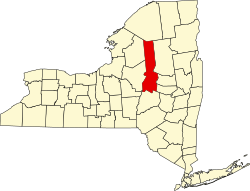North Columbia, New York | |
|---|---|
| Coordinates: 42°58′40″N75°04′18″W / 42.97778°N 75.07167°W | |
| Country | United States |
| State | New York |
| County | Herkimer |
| Town | Columbia |
| Elevation | 1,230 [1] ft (375 m) |
| Time zone | UTC-5 (Eastern (EST)) |
| • Summer (DST) | UTC-4 (EDT) |
| Area codes | 315/680 |
North Columbia is a hamlet located in the Town of Columbia in Herkimer County, New York, United States.


